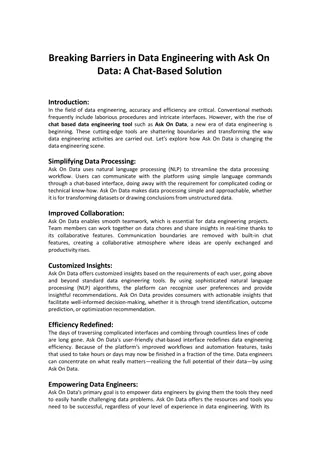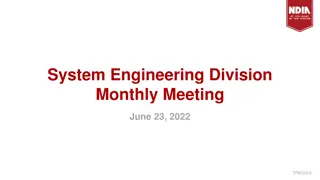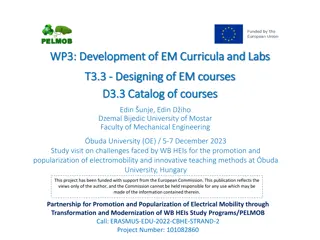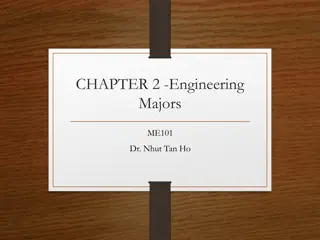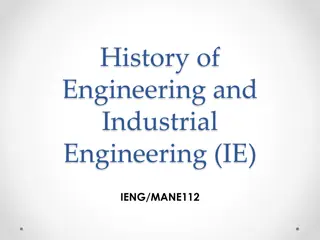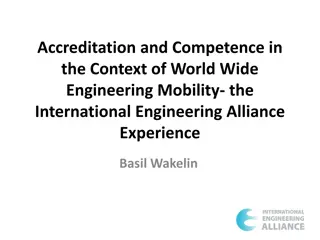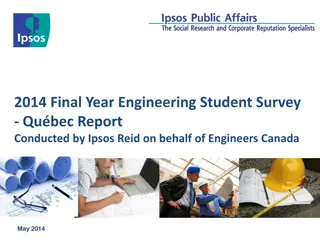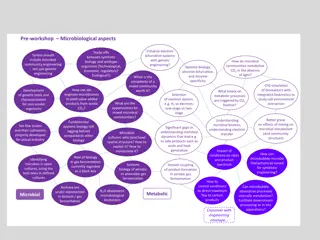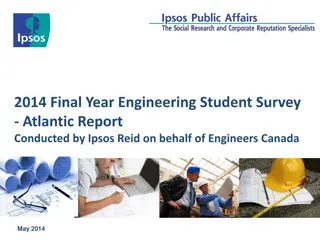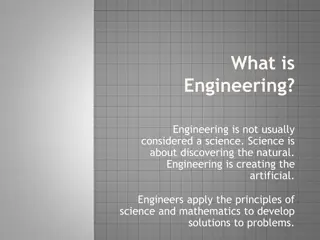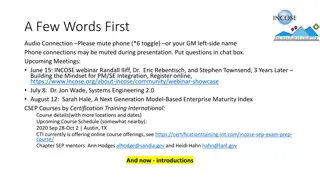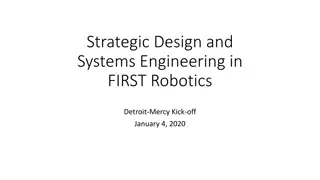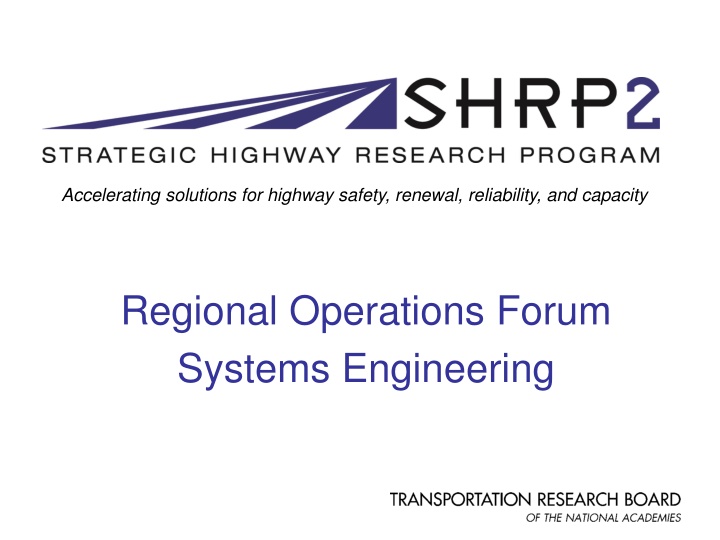
Enhancing Highway Safety and Efficiency Through Systems Engineering
Discover the significance of systems engineering in improving highway safety, reliability, and capacity. Learn how this interdisciplinary approach ensures the successful development of systems by considering various factors such as customer needs, functionality, operations, performance, and cost.
Download Presentation

Please find below an Image/Link to download the presentation.
The content on the website is provided AS IS for your information and personal use only. It may not be sold, licensed, or shared on other websites without obtaining consent from the author. If you encounter any issues during the download, it is possible that the publisher has removed the file from their server.
You are allowed to download the files provided on this website for personal or commercial use, subject to the condition that they are used lawfully. All files are the property of their respective owners.
The content on the website is provided AS IS for your information and personal use only. It may not be sold, licensed, or shared on other websites without obtaining consent from the author.
E N D
Presentation Transcript
Accelerating solutions for highway safety, renewal, reliability, and capacity Regional Operations Forum Systems Engineering
What Is Systems Engineering? From MIT Open Course: Systems Engineering is an interdisciplinary approach and means to enable the realization of successful systems. It focuses on defining customer needs and required functionality early in the development cycle, documenting requirements, then proceeding with design synthesis and system validation while considering the complete problem including operations, performance, test, manufacturing, cost, and schedule. 2
Why Is Systems Engineering Important? A tool to help with: Reflecting the needs of the users in system development Keeping the project on schedule and budget Ability to repeat successes/deliver predictable outcomes Addressing risks early when system costs are lowest Better documentation of the system no mysteries Increasing system reliability and stability 3
Better Systems Engineering Leads to Better System Quality/Value Lower Cost Shorter Schedule Reduced Risk 5 25% 50% 20% 15% 20% 30% 10 Mar, Honour; Value of Systems Engineering 2002 INCOSE Symposium Module I: Systems Engineering for Transportation Projects in a Nutshell 4
The Systems Engineering Process The V Model 5
Cross-Cutting Systems Engineering Activities 6
Concept of Operations Describes the problem to be solved and how the stakeholders will solve the problem using the system Facilitates understanding of goals Forms the basis for long-range planning Presents an integrated view of the stakeholder organization and mission ANSI/AIAA G-043-1992 Guide for the Preparation of Operational Concept Documents 7
Systems Engineering Exercise The states of Lincoln and Jefferson are planning to implement a new ramp metering system. Lincoln DOT currently meters the I-450 corridor in the Monroe metropolitan area. Lincoln DOT will use this project to implement metering on I-450. Jefferson DOT currently does not meter any ramps. They propose to meter both I-50 and I-450. The first phase will add meters on I-50 inside the I-450 interchange approaching Buchanan. 8
Exercise System Description Both agencies agree that there should be one central system. Both agree that it should be operated out of LDOT s TMC. There will be a satellite system in the JDOT TMC. The new/expanded metering system will include new software and hardware. A new algorithm will be implemented. 9
Team Exercise Would you consider this to be a complex project? Should consideration be given to simplifying the SE process? If so, in what way? How would you define the system that will be covered by the project and the concept of operations? What stakeholders should be involved in developing the concept of operations? 10
SE Experiences by State How are you applying systems engineering in your organization? What benefits did you experience? 11
Accelerating solutions for highway safety, renewal, reliability, and capacity Regional Operations Forum Systems Engineering Supporting Information
The FHWA Final Rule on Architecture and Standards Conformity (23 CFR 940) Issued on January 8, 2001 Ensures that projects are developed according to predefined criteria and comply with the National ITS Architecture and applicable ITS standards SE should be commensurate with project scope: Enough so that it supports good outcomes meaningfully Requires a systems engineering analysis: Identification of the portion of the regional architecture being implemented Identification of participating agencies Definition of requirements Analysis of alternatives Identification or selection of procurement options Selection and definition of applicable standards and testing procedures Identification of resources for operations and maintenance of the system 13
Developing the Concept of Operations Procedures Deployment Performance Utilization Effectiveness Life cycle Environment Maintenance Develop a vision of how you will use the system Identify Stakeholders 14
A Concept of Operations Two different industry standards provide suggested outlines for concepts of operations are shown below. ANSI/AIAA-G-043 Outline (1992) 1. Scope 2. Referenced Documents 3. User-Oriented Operational Description 4. Operational Needs 5. System Overview 6. Operational Environment 7. Support Environment 8. Operational Scenarios IEEE Std 1362 (1998) 1. Scope 2. Referenced Documents 3. The Current System or Situation 4. Justification for and Nature of the Changes 5. Concepts for the Proposed System 6. Operational Scenarios 7. Summary of Impacts 8. Analysis of the Proposed System 15
Requirements Something that governs what, how well and under what conditions a product will achieve a given purpose. Functional Requirements Interface Requirements Performance Requirements Data Requirements 16
Characteristics of Good Requirements Requirements must be: Necessary Clear (unambiguous) Complete Driven by needs in the ConOps Achievable (feasible) Testable and measurable (quantifiable) Technology independent 17
Characteristics of Bad Requirements Requirements must NOT be: Vague Compound A mix of interim goals and final output Dependent on a technology Poorly linked to customer expectations Subjective Qualitative Design prescriptive 18
Managing Requirements Requirements are the basis for acquisition, design, and acceptance. Traceability is critical Requirements should be included in configuration management. Should we freeze requirements? Why? Under what conditions? If so, when? Should we ever relax requirements once they are established? Before we make a build vs buy decision? After we have selected a contractor Under what conditions? 19
Scaling SE Process: Complex Projects High-Risk Indicators The presence of one or more of these factors indicates a higher risk situation: 1. Multijurisdictional and/or multimodal 2. New software creation 3. New hardware integration 4. New interfaces especially if to external systems 5. System requirements not well understood and written down 6. New technology applications, likely technology changes 20
Scaling SE Process: Complex Project Example The Project: Share control of existing CCTV cameras between state DOT and adjoining city. Let s see how the high-risk factors apply: Multijurisdictional and/or multimodal New software creation New hardware integration New interfaces System requirements not well understood New technology applications, likely technology changes This is a high-risk application. Follow the V with no shortcuts! 21
Scaling SE Process: Simpler Projects Low-Risk Indicators A low-risk ITS project should have all of these characteristics: 1. Single jurisdiction and/or single mode 2. No software creation 3. Proven hardware and communication 4. No new interfaces 5. System requirements/operating procedures well defined and documented 6. Only stable technologies used 22
Scaling SE Process: Simpler Projects Low-Risk Project Example The Project: Add 4 CCTV Cameras to a surveillance system currently including 10 cameras Let s see how the low-risk factors apply: Single jurisdiction and/or single mode No software creation Proven hardware and communication No external interfaces; duplication of existing ones System requirements well defined/documented Only stable technologies used This project is a good example of a low-risk application. All low-risk factors apply. 23
So, What Can I Do to Simplify the SE Process on Simpler Projects? You still have to follow the V However, there are ways to make it easier: Use existing resources Existing ConOps Existing requirements (even if they have to be modified) Adapt existing test scripts Determine where manufacturer certifications or results from tests elsewhere can be used Scale the ConOps to the project Look to buy instead of build Use high level requirements to compare existing systems You still have the cross-cutting activities. Follow the V ! 24
Takeaways: Applying Systems Engineering in Your Organization Communicate the value of systems engineering Better documentation, more stakeholder participation, reflect user needs, address risks, increased system reliability and stability, repeat successes Applying it to projects use of the V Model and FHWA Final Rule Improving internal capabilities e.g., project, risk, and configuration management Marking it part of the organization culture establishing policies and documenting processes Implementing across the organization 25
Resources ITS Professional Capacity Building (PCB) Program: http://www.pcb.its.dot.gov/ (Comprehensive, accessible, and flexible ITS learning for the transportation industry) ITS Peer-to-Peer Program - http://www.its.dot.gov/peer/index.htm (Provides public sector transportation stakeholders with a convenient method to tap into the growing knowledge base of ITS experience and receive short-term assistance) Systems Engineering Web Page: http://www.ops.fhwa.dot.gov/int_its_deployment/sys_eng.htm (Comprehensive, accessible, and flexible ITS learning for the transportation industry) Talking Transportation and Technology (T3) Webinars: Live webinars on cutting-edge topics: http://www.pcb.its.dot.gov/t3_webinars.aspx Archivedwebinarsessions: http://www.pcb.its.dot.gov/t3_archives.aspx 26


